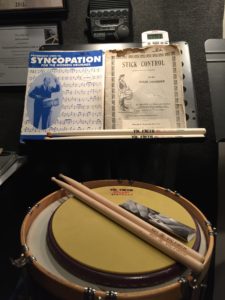Materials and Equipment Needed
These are the required materials and equipment you will need to begin a successful foray into drum lessons.
Drum Sticks
Students will need sticks for both snare drum and drum set work. Drumsticks come in a dizzying array of sizes and shapes. Drumsticks are a drummer’s tools (materials & equipment) so we need the right tool for the right job. You do not use a framing hammer to set a tiny finishing nail in a piece of fine furniture and likewise trying to drive a 20# nail into a wall frame with a finishing hammer is a less than rewarding experience.
I am affiliated with the Vic Firth Company as a PDT (Private Drum Teacher). I use these products for a number of reasons. One of the main reasons I use and recommend their sticks is the flag. Each Vic Firth drumstick has an American flag printed on the shaft. The location of the flag on the stick is the balancing point of the stick. This is very important when developing proper grip and stroke techniques.
I recommended the following sticks:
- Vic Firth SD1 or SD1 Jr. for snare drum and practice pad work
- Vic Firth Corpsmaster Signature Ralph Hardimon and Ralphie Jr. for Rudimental/Marching work
- Vic Firth 5A or 5B for drum set
 Practice Pad
Practice Pad
A good practice pad (even if the student owns a drum set and/or a snare drum) is a must. Again we need the right tool for the right job. A good practice pad will help with developing stroke techniques and aid in good timing and dynamics.
Recommended practice pads include:
- Vic Firth Heavy Hitter Stock Pad or Slim Pad (available here)
- Vic Firth Single Sided Practice Pad (available here)
- Aquarian Tru-Bounce Practice Pad (available here)
- HQ Percussion 12″ Real Feel Pad (available here)
note: all the pads mentioned above are available from your local music store
Metronome
This is a MUST HAVE piece of equipment. Especially for beginners! Our job as drummers is to accept, maintain and sub-divide time. The sooner a student can develop steady time the quicker he/she will advance. A metronome is a tool we use to develop accurate time. The good news is there are now some VERY good metronome apps that run on smartphones as well as the dedicated hardware models.
Recommended metronomes include:
- Apps
- Metronome Plus – (iOS $1.99)
- Tempo or Tempo Advance – Tempo (iOS $1.99 & Android $.99); Tempo Advance (iOS only $2.99)
- Time Guru – (iOS $2.99 & Android $1.99)
- Dr. Betotte – (iOS $9.99)
- Hardware
- Korg MA-30
- Boss DB-30 Dr. Beat
- Tama RW-100 or RW-105 (for the truly dedicated student)
Timer:
In addition to a good metronome, a simple kitchen-style timer or a watch with a timer function is recommended for keeping track of practice session duration.
Recommended Books:
In 1993 Modern Drummer Magazine published their “25 Greatest Drum Books” article. The article contained a list of the 25 most used books by teachers and educators from around the country. Based on that article and my own experience of being a “student of the drums” as well as a teacher I feel that if there was a ‘Bible of Drumming’ it would be of 2 parts. The Old Testament would be represented by Stick Control for the Snare Drummer and the New Testament would be Syncopation for the Modern Drummer. There are hundreds, maybe at this point, thousands of good books out there for learning how to play drums but these two books are the starting point for anyone serious about becoming a good drummer.
I use the following books for reading and rudimental development:
- Stick Control for the Snare Drummer – considered by many to be the bible of drum books, as valid today as the day it was written
- Syncopation for the Modern Drummer – One of the most versatile and practical drum books ever
- Alfred’s Drum Method Book 1 & 2
In addition, I have several topic-specific handouts that I have developed. Several snare drum solo and duet books and pieces are introduced depending on the student’s goals and ability.
Drum set students will work out of:
- Drumset 101 – A Contemporary Approach to Playing the Drums
- Alfred’s Kid’s Drum Set Method
- Ultimate Realistic Rock
- Advanced Techniques For The Modern Drummer
- The Commandments of Early Rhythm and Blues Drumming
In addition, students will work with various CD’s, DVD’s, and Play-Along’s as the student progresses including:
- The Turn It Up and Lay It Down Series
- Groove Essentials
I will also develop a playlist of songs for students to work on to learn new styles and methods and other materials may be suggested or introduced as needed.
